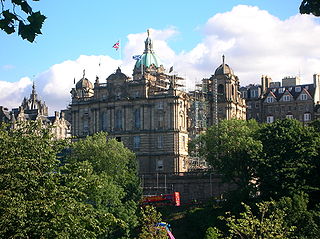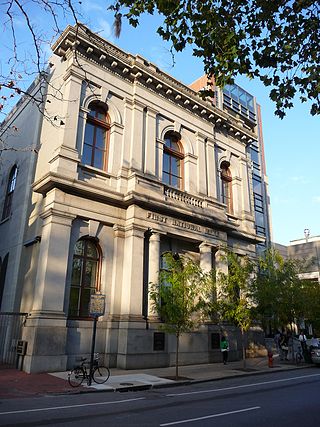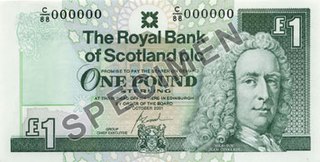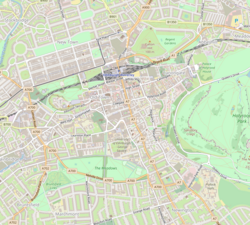
The Bank of England is the central bank of the United Kingdom and the model on which most modern central banks have been based. Established in 1694 to act as the English Government's banker, and still one of the bankers for the Government of the United Kingdom, it is the world's eighth-oldest bank. It was privately owned by stockholders from its foundation in 1694 until it was nationalised in 1946 by the Attlee ministry.

The pound sterling is the official currency of the United Kingdom, Jersey, Guernsey, the Isle of Man, British Antarctic Territory, South Georgia and the South Sandwich Islands, and Tristan da Cunha.

The Bank of Scotland plc is a commercial and clearing bank based in Scotland and is part of the Lloyds Banking Group. The bank was established by the Parliament of Scotland in 1695 to develop Scotland's trade with other countries, and aimed to create a stable banking system in the Kingdom of Scotland.

Halifax is a British banking brand operating as a trading division of Bank of Scotland, itself a wholly owned subsidiary of Lloyds Banking Group.

Clydesdale Bank is a trading name used by Clydesdale Bank plc for its retail banking operations in Scotland.

Lloyds Bank plc is a British retail and commercial bank with branches across England and Wales. It has traditionally been considered one of the "Big Four" clearing banks. Lloyds Bank is the largest retail bank in Britain, and has an extensive network of branches and ATMs in England and Wales and offers 24-hour telephone and online banking services.

The Crime Museum is a collection of criminal memorabilia kept at New Scotland Yard, headquarters of the Metropolitan Police Service in London, England. Known as the Black Museum until the early 21st century, the museum came into existence at Scotland Yard sometime in 1874, arising out of the collection of prisoners' property gathered as a result of the Forfeiture Act 1870 and intended as an aid to the police in their study of crime and criminals. Initially unofficial, it had become an official if private museum by 1875, with a police inspector and a police constable assigned to official duty there. Not open to the public, it was used as a teaching collection for police recruits and was only ever accessible by those involved in legal matters, royals and other VIPs.
The pound is the currency of the Isle of Man, at parity with sterling. The Manx pound is divided into 100 pence. Notes and coins, denominated in pounds and pence, are issued by the Isle of Man Government.

The Bank Charter Act 1844, sometimes referred to as the Peel Banking Act of 1844, was an Act of the Parliament of the United Kingdom, passed under the government of Robert Peel, which restricted the powers of British banks and gave exclusive note-issuing powers to the central Bank of England. It is one of the Bank of England Acts 1694 to 1892.

The Royal Bank of Scotland plc is a major retail and commercial bank in Scotland. It is one of the retail banking subsidiaries of NatWest Group, together with NatWest and Ulster Bank. The Royal Bank of Scotland has around 700 branches, mainly in Scotland, though there are branches in many larger towns and cities throughout England and Wales. The bank is completely separate from the fellow Edinburgh-based bank, the Bank of Scotland, which pre-dates the Royal Bank by 32 years. The Royal Bank of Scotland was established to provide a bank with strong Hanoverian and Whig ties.

Surgeons' Hall in Edinburgh, Scotland, is the headquarters of the Royal College of Surgeons of Edinburgh (RCSEd). It houses the Surgeons' Hall Museum, and the library and archive of the RCSEd. The present Surgeons' Hall was designed by William Henry Playfair and completed in 1832, and is a category A listed building.

The National Museum of Scotland in Edinburgh, Scotland is a museum of Scottish history and culture.
Banknotes of Scotland are the banknotes of the pound sterling that are issued by three Scottish retail banks and in circulation in Scotland. The issuing of banknotes by retail banks in Scotland is subject to the Banking Act 2009, which repealed all earlier legislation under which banknote issuance was regulated, and the Scottish and Northern Ireland Banknote Regulations 2009. Currently, three retail banks are allowed to print notes for circulation in Scotland: Bank of Scotland, Royal Bank of Scotland, and Clydesdale Bank.

HBOS plc is a banking and insurance company in the United Kingdom, a wholly owned subsidiary of the Lloyds Banking Group, having been taken over in January 2009. It was the holding company for Bank of Scotland plc, which operated the Bank of Scotland and Halifax brands in the UK, as well as HBOS Australia and HBOS Insurance & Investment Group Limited, the group's insurance division.

Dundas House is a Neoclassical building in Edinburgh, Scotland. It is located at 36 St Andrew Square, in the city's first New Town. The building was completed in 1774 as a private town house for Sir Lawrence Dundas by the architect Sir William Chambers. Much altered internally and extended over the years, today it is the registered office of the Royal Bank of Scotland and its parent, NatWest Group and is protected as a category A listed building.

The Montrose Air Station Heritage Centre is located to the North of Montrose, Angus, Scotland. Montrose has the distinction of having the first operational military airfield in Great Britain and the Heritage Centre is located on the former airfield.

First National Bank was a bank in Philadelphia. Chartered in 1863, it was the first national bank created under the Civil War banking reforms that began to define the modern U.S. banking system, and the first commercial bank to issue a federal banknote. It operated independently until 1955, when it was merged into the Bank of North America and Trust Company, which now is part of Wells Fargo.

The Royal Bank of Scotland £1 note is a sterling banknote. The current cotton note, first issued in 1987, bears an image of Lord Ilay, one of the founders of the bank, on the obverse, and a vignette of Edinburgh Castle on the reverse.

The Clydesdale Bank £10 note, also known informally as a tenner, is a sterling banknote. It is the second smallest denomination of banknote issued by the Clydesdale Bank. The current polymer note, first issued in 2017, bears an image of Scottish poet Robert Burns on the obverse and a vignette of the Old and New Towns of Edinburgh on the reverse.

State Bank of Pakistan Museum & Art Gallery is a museum on Ibrahim Ismail Chundrigar Road in Karachi, established in 2004 to introduce the first Monetary Museum of Pakistan. The current State Bank of Pakistan Museum & Art Gallery building, previously the Imperial Bank of India, is a Greco Roman building in Jodhpuri Red Sandstone constructed in the 1920s by the British government. In 2004, the State Bank of Pakistan decided to adapt the building as a museum; work on the projects started in 2006 and was devoted to conservation of the building and acquisition of the collection.






















